Udio AI Review 2025: The Ultimate Guide to AI Music Generation
The landscape of AI music creation has evolved dramatically in 2025, with artificial intelligence transforming how we compose, produce, and experience music. Among the leading platforms revolutionizing this space, Udio AI stands out as a powerful contender that’s making waves in the AI music generation community. This comprehensive udio AI review 2025 will explore everything you need to know about this innovative platform, from its cutting-edge features to its practical applications for creators at every level.
As we dive deeper into the world of AI-powered music creation, it’s becoming increasingly clear that tools like Udio are not just novelties—they’re genuine game-changers for musicians, content creators, and anyone looking to harness the power of artificial intelligence for musical expression. Whether you’re searching for an ai music generator free no sign up solution or reading this Udio AI Review 2025 to compare professional-grade platforms for commercial projects, understanding Udio’s capabilities and limitations is essential for making informed decisions about your music creation toolkit.
What Makes Udio AI Special in 2025
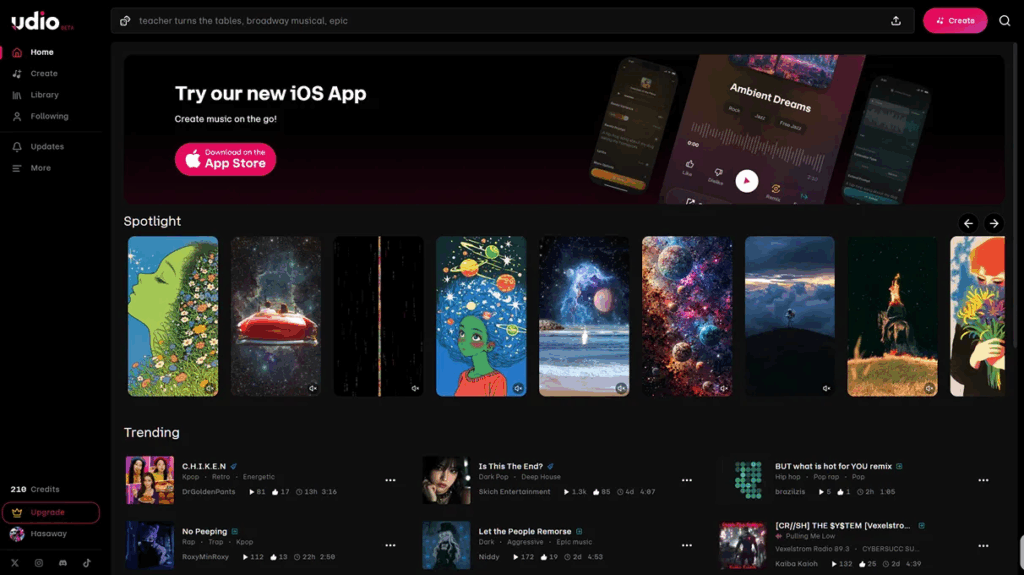
Udio AI has positioned itself as one of the most sophisticated AI music generators available today, offering users the ability to create complete, professional-quality songs from simple text prompts. Udio is an AI music generator capable of composing complete, ultra-realistic songs, and what sets it apart from other ai music free platforms is its remarkable ability to generate both instrumental tracks and vocal performances that sound remarkably human-like.
The platform’s standout feature is its advanced understanding of musical structure, genre conventions, and stylistic nuances. Unlike basic ai song generator tools that might produce repetitive loops or disconnected segments, Udio creates coherent, full-length compositions that follow traditional song structures while maintaining creative originality. This makes it particularly valuable for users who want more than just background music—they’re looking for complete songs that could theoretically be released commercially.
For content creators exploring the platform through udio ai review 2025 youtube videos, one of the most impressive aspects is Udio’s vocal synthesis technology. The platform can generate singing voices across multiple genres, from pop and rock to hip-hop and electronic music. These aren’t robotic-sounding vocals; they’re expressive, emotionally resonant performances that demonstrate the significant advances in AI voice technology.
Another key differentiator is Udio’s approach to genre versatility. While many AI music production software tools excel in specific areas, Udio demonstrates impressive competence across a wide range of musical styles. Whether you’re looking to create a soulful ballad, an energetic electronic dance track, or a country anthem, the platform adapts its generation algorithms to match the stylistic requirements of your chosen genre.
The platform’s user interface deserves special mention as well. Despite the sophisticated technology powering it, Udio maintains an intuitive, beginner-friendly design that doesn’t overwhelm newcomers to AI music creation. This accessibility factor is crucial for the platform’s adoption among users who might be intimidated by more complex AI tools for music creation 2025.
Key Features and Capabilities
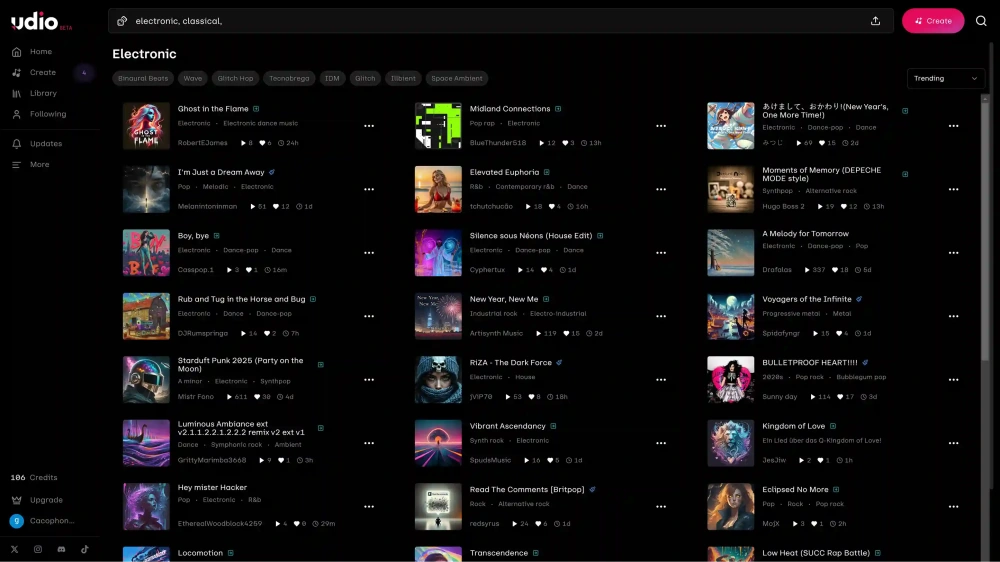
In this Udio AI Review 2025, we explore the platform’s most powerful features and how they compare to other top-tier AI music generators. Udio’s feature set represents a comprehensive approach to AI music generation that goes beyond simple melody creation. The platform offers several core capabilities that make it a standout choice among the best AI music generators available today.
The text-to-music generation feature is perhaps the most fundamental and impressive aspect of Udio. Users can input descriptive prompts ranging from simple genre specifications to detailed emotional and atmospheric descriptions. The AI interprets these prompts and generates complete musical arrangements that match the specified criteria. This process typically takes just a few minutes, making it incredibly efficient for rapid prototyping and creative exploration.
Genre flexibility is another cornerstone of Udio’s appeal. The platform has been trained on extensive musical datasets spanning decades of popular music, allowing it to understand and replicate the characteristics of virtually any mainstream genre. From classical orchestral arrangements to modern trap beats, Udio can adapt its generation process to match the stylistic requirements of your project.
The vocal generation capabilities deserve particular attention in any comprehensive udio AI review 2025. The platform can create both male and female vocal performances, with the ability to adjust vocal characteristics based on the genre and mood of the song. These vocals aren’t just melodic placeholders—they include realistic breathing patterns, emotional inflections, and the subtle imperfections that make human singing compelling.
Udio also offers customization options that allow users to refine their generated music beyond the initial creation. Users can specify instrumentation preferences, adjust song structure elements, and even provide reference tracks to guide the AI’s creative process. This level of control bridges the gap between fully automated generation and human creative input.
The platform’s audio quality is consistently high, with generated tracks available in professional formats suitable for commercial use. This is particularly important for users who plan to incorporate AI-generated music into commercial projects, as the output quality needs to meet industry standards.
For users interested in collaborative features, Udio provides options for sharing and iterating on generated compositions. This makes it valuable for teams working on multimedia projects or musicians who want to use AI-generated material as a starting point for further human composition and arrangement.
Pricing and Accessibility Options
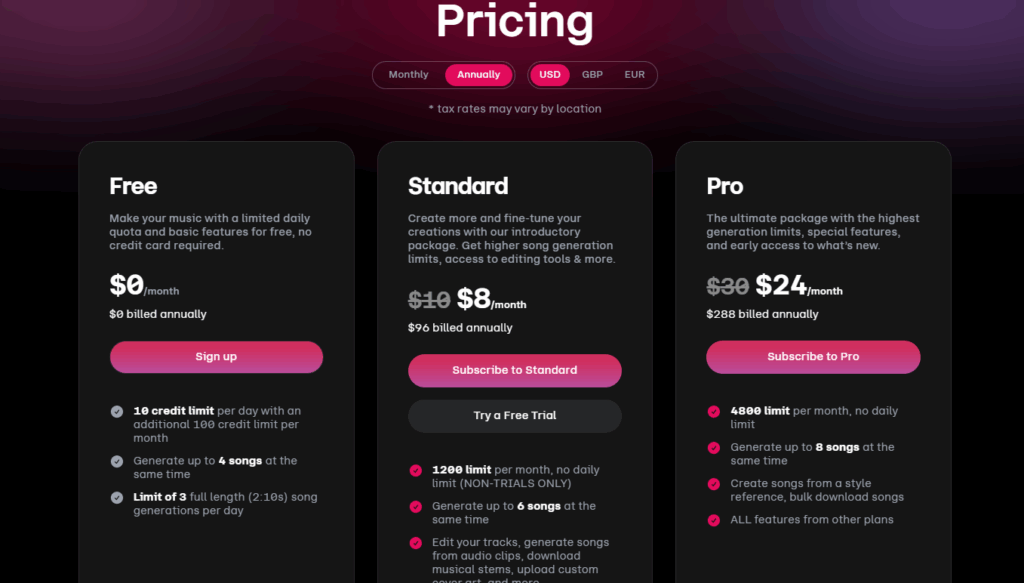
Understanding Udio’s pricing structure is crucial for anyone considering the platform for their music creation needs. The platform offers multiple tiers designed to accommodate different usage levels and budgets, making it accessible to both casual users and professional creators.
The free tier provides an excellent entry point for users who want to explore Udio’s capabilities without financial commitment. Yes, It offers a free tier with basic features and a daily quota, allowing new users to generate a limited number of tracks per day. This approach is particularly valuable for those seeking an ai music generator free download experience, as it provides genuine functionality without requiring immediate payment.
For users ready to invest more seriously in AI music creation, At $10 per month, you will get the standard introductory package with a higher generation limit and early access to more features. This pricing point positions Udio competitively within the AI music generation market, offering substantial value for the quality and quantity of music it can produce.
The Pro tier represents excellent value for content creators, small businesses, and serious hobbyists who need regular access to AI-generated music. The increased generation limits mean users can create multiple tracks per day, making it suitable for projects requiring extensive musical content. The early access to new features also ensures that Pro subscribers can take advantage of Udio’s latest capabilities as they’re released.
For users researching udio ai review 2025 free options, it’s important to note that while the free tier provides genuine functionality, the limitations are designed to encourage upgrades for users who find value in the platform. The daily quotas ensure that casual users can explore the platform without cost, while more intensive users will naturally gravitate toward paid tiers.
The pricing structure also reflects Udio’s position in the broader landscape of AI music production software. Compared to traditional digital audio workstations or sample libraries, Udio’s subscription model offers access to virtually unlimited musical content generation, making it a cost-effective solution for many use cases.
Android Compatibility and Mobile Experience
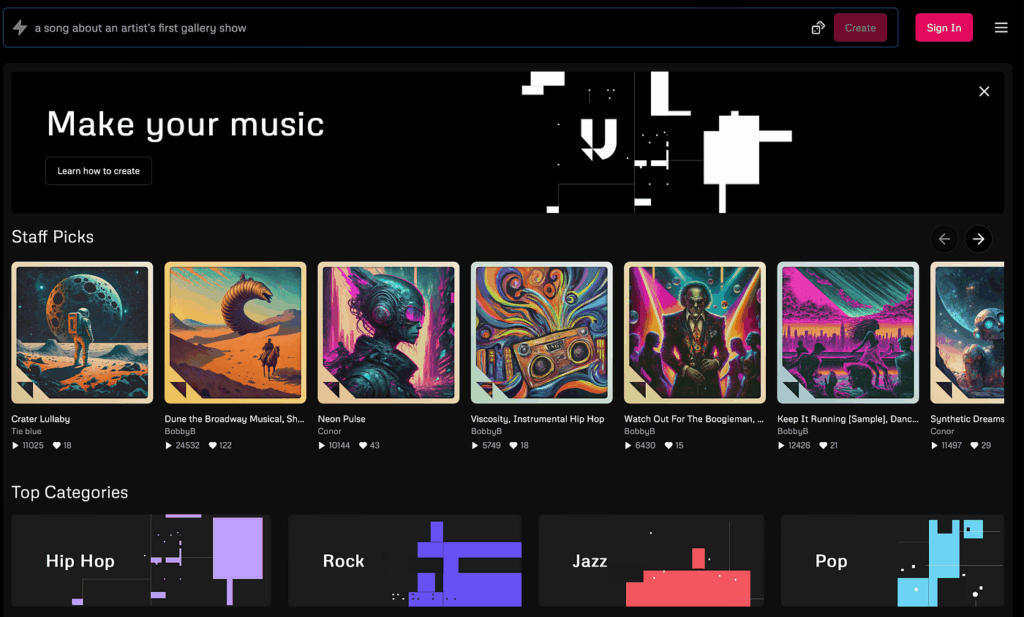
Mobile accessibility has become increasingly important for AI music generation tools, and Udio’s approach to mobile compatibility addresses this growing demand. While researching udio ai review 2025 android compatibility, it’s important to understand the current state of mobile support and the platform’s roadmap for mobile development.
Currently, Udio operates as a web-based platform, which means Android users can access the service through their mobile browsers. This approach provides broad compatibility across different Android devices and versions without requiring users to download and install dedicated applications. The web interface is optimized for mobile viewing, ensuring that essential features remain accessible on smaller screens.
The mobile browser experience offers most of Udio’s core functionality, including text-to-music generation, playback controls, and basic editing features. Users can create music prompts, generate tracks, and listen to results directly from their Android devices. This accessibility makes Udio particularly valuable for content creators who need to generate music while mobile or away from their primary workstations.
However, the mobile experience does have some limitations compared to desktop usage. Complex editing features and detailed customization options are more challenging to navigate on mobile devices, and the audio quality assessment might be limited by device speaker capabilities. For serious music production work, desktop access remains preferable, but mobile access serves well for inspiration, quick generation, and basic review tasks.
Looking ahead, the demand for native mobile applications for AI music generation tools continues to grow. Many users seeking free AI song creator apps specifically want dedicated mobile applications that can work offline or provide enhanced mobile-specific features. While Udio hasn’t announced specific plans for native Android applications, the trend in AI music production software suggests that mobile-first approaches will become increasingly important.
For users comparing mobile AI music generation options, Udio’s web-based approach offers immediate accessibility without storage requirements, but those preferring native applications might need to consider other platforms in the ai music generator free download category that offer dedicated mobile apps.
Comparing Udio with Suno AI and Other Alternatives
The AI music generation landscape includes several notable competitors, with Suno AI being Udio’s most direct rival. As part of our in-depth Udio AI Review 2025, understanding how these platforms compare helps users make informed decisions about which tool best suits their needs and creative goals.
AI music makers are crushing it right now. The two titans of the field are Udio and Suno, and both platforms have established themselves as leaders in the AI music generation space. The competition between these platforms drives continuous innovation and improvements, benefiting users regardless of their choice.
Suno AI has gained significant recognition for its user-friendly interface and quick generation times. The platform excels at creating catchy, commercial-sounding tracks that closely follow user prompts. I’d say Suno is a bit better in following your prompt closely and in terms of how natural the vocals sound, which makes it particularly appealing for users who want predictable results that match their specific requirements.
In terms of vocal quality, both platforms demonstrate impressive capabilities, but they each have distinct characteristics. Suno tends to produce vocals that sound more immediately polished and radio-ready, while Udio’s vocals often have more character and emotional depth. The choice between them often depends on whether users prioritize commercial polish or artistic expression.
Genre handling represents another area where these platforms show different strengths. Udio demonstrates particular excellence in rock, pop, and electronic music genres, with sophisticated understanding of production techniques and instrumental arrangements. Suno performs well across a broader range of genres but sometimes lacks the nuanced understanding of specific sub-genres that Udio provides.
When considering alternatives beyond these two leaders, several other platforms deserve mention in the best AI music generators conversation. Boomy and Suno AI are especially good for instant songs, while Beatoven and Mubert are fantastic for background tracks. This diversity in the market means users can find specialized tools for specific applications, whether they need complete songs, background music, or instrumental loops.
For users interested in ai song generator based on artist functionality, both Udio and Suno offer capabilities to create music in the style of specific artists or genres, though they approach this differently. Udio tends to focus more on capturing the essence of musical styles and production techniques, while Suno emphasizes matching the surface-level characteristics that users might associate with particular artists.
The pricing comparison between these platforms also influences user decisions. While Suno and Udio offer similar pricing structures, the value proposition differs based on generation limits, audio quality, and feature sets. Users should consider their specific needs when evaluating these options, as the best choice depends on individual usage patterns and creative goals.
Practical Applications and Use Cases
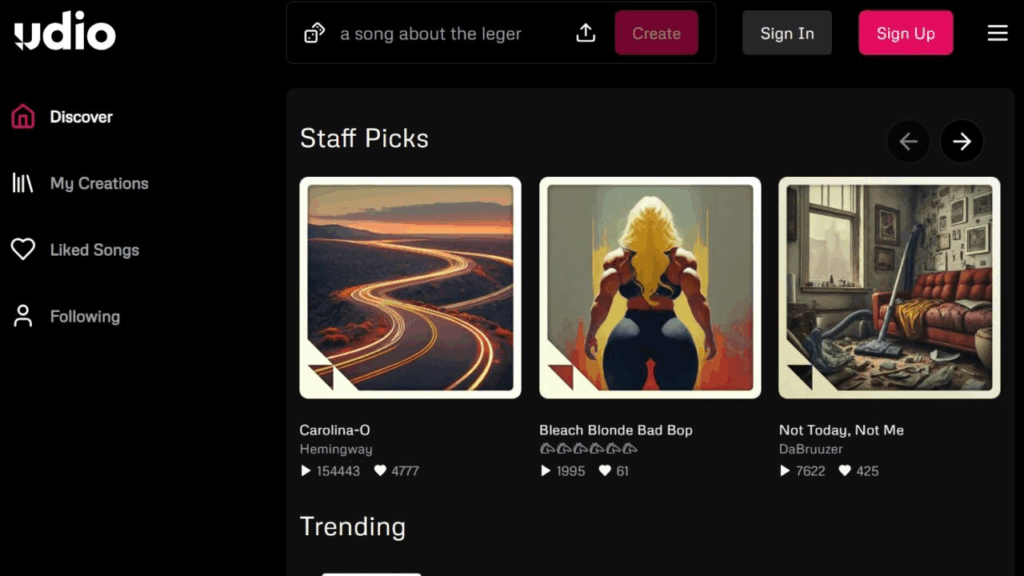
Udio’s versatility makes it valuable across numerous creative and commercial applications. Understanding these use cases helps potential users identify how the platform might fit into their specific workflows and projects.
Content creators represent one of the largest user groups for AI music generation tools. YouTubers, podcasters, and social media creators often need original music for their content but lack the budget for custom compositions or the rights to use commercial music. Udio provides a solution by generating original, royalty-free music that can be customized to match the tone and energy of specific content pieces.
Film and video production presents another significant application area. Independent filmmakers and video producers frequently need music for scenes, transitions, and emotional moments. Udio can generate atmospheric pieces, tension-building scores, and emotional soundscapes that would traditionally require hiring composers or purchasing expensive stock music licenses.
The advertising and marketing industry has also embraced AI music generation tools. Used by therapists for creating therapeutic music sessions; Utilized by fitness instructors to design workout-specific playlists demonstrates the platform’s versatility beyond traditional music production. Marketing teams use Udio to create jingles, background music for commercials, and audio branding elements that align with campaign themes.
Gaming represents an emerging application area where AI music generation shows particular promise. Indie game developers often need extensive musical content for different game levels, character themes, and interactive sequences. Udio can generate cohesive musical themes and variations that provide the variety needed for immersive gaming experiences.
Educational applications are also growing in importance. Music educators use AI generation tools to create examples of different musical styles, demonstrate composition techniques, and provide students with diverse musical experiences. The ability to generate music in specific styles on demand makes these tools valuable for teaching music theory and composition concepts.
For therapeutic applications, the ability to generate calming, energizing, or emotionally specific music has found applications in healthcare settings. While not a replacement for professional music therapy, AI-generated music can support wellness programs and stress reduction initiatives.
The podcasting industry has particularly benefited from AI music generation tools. Podcast creators need intro music, outro themes, transition sounds, and background music for different segments. Udio’s ability to generate consistent musical themes while providing variations keeps podcast audio fresh and engaging.
Technical Performance and Audio Quality
The technical aspects of Udio’s performance directly impact user experience and determine the platform’s suitability for different applications. Understanding these technical capabilities helps users set appropriate expectations and make informed decisions about when and how to use the platform.
Audio quality represents the most critical technical aspect for any AI music generation tool. Udio produces high-quality audio output that meets professional standards for most applications. The platform generates audio at standard sample rates and bit depths that are compatible with professional audio equipment and software. This quality level makes Udio suitable for commercial applications where audio fidelity is crucial.
Generation speed is another important technical consideration. Most Udio generations complete within 2-5 minutes, depending on the complexity of the requested music and server load. This speed makes the platform practical for creative workflows where quick iteration and experimentation are important. Users can generate multiple variations of a musical idea rapidly, facilitating the creative process.
The platform’s ability to maintain consistency across generations is particularly impressive. When users request multiple variations of a theme or need to create extended pieces, Udio maintains stylistic coherence that makes the resulting music feel like it comes from a single creative source. This consistency is crucial for applications requiring multiple related musical pieces.
Server reliability and uptime have generally been strong, though users should be aware that as a web-based platform, Udio’s availability depends on internet connectivity and server performance. The platform has experienced occasional high-traffic periods that resulted in slower generation times, but these issues have been relatively infrequent.
The platform’s handling of different musical complexities shows sophisticated understanding of arrangement and production principles. Simple requests for acoustic guitar ballads generate appropriately intimate productions, while requests for orchestral pieces result in fuller, more complex arrangements. This adaptability demonstrates the AI’s musical intelligence and training sophistication.
Audio format compatibility ensures that generated music works seamlessly with standard audio editing software and publishing platforms. Users can download their generated music in common formats and integrate it into existing workflows without technical complications.
User Experience and Interface Design
The user experience design of Udio reflects a thoughtful approach to making AI music generation accessible to users with varying levels of technical expertise. The platform’s interface balances powerful functionality with intuitive operation, making it appealing to both beginners and experienced creators.
The prompt input system represents the primary interface element, and its design significantly impacts user success. Udio’s prompt interface encourages descriptive text input while providing examples and suggestions that help users understand how to communicate effectively with the AI. This guidance is particularly valuable for users new to AI music generation who might not initially understand how to craft effective prompts.
The generation process provides clear feedback about progress and estimated completion times, helping users understand what to expect during the creation process. Visual indicators show when generation is active, and the interface provides options for users to work on other tasks while waiting for completion.
Playback controls are designed for easy music review and evaluation. Users can quickly play generated tracks, skip to different sections, and compare multiple generations side by side. These features facilitate the iterative process of refining musical ideas and selecting the best results from multiple attempts.
The platform’s organization of generated music helps users manage their creative output effectively. Users can save, categorize, and revisit previous generations, making it easy to build libraries of musical material for ongoing projects. This organizational capability is particularly important for users who generate large quantities of music.
Download and export options are streamlined to minimize friction between generation and implementation. Users can quickly obtain their music in appropriate formats for their intended applications, whether that’s immediate use in video editing software or archival storage for future projects.
The overall aesthetic design of the interface conveys professionalism while remaining approachable. The visual design doesn’t overwhelm users with complex controls, but it provides access to the depth of functionality that serious creators need. This balance is crucial for attracting users across different skill levels and use cases.
Comparison Table: Udio vs. Leading AI Music Generators
| Feature | Udio AI | Suno AI | Soundverse | Boomy | Mubert |
| Vocal Generation | High-quality, expressive vocals | Natural-sounding, polished vocals | Professional vocals | Basic vocal options | Instrumental focus |
| Genre Versatility | Excellent across multiple genres | Strong pop/commercial focus | Wide range with customization | Pop and electronic focus | Electronic and ambient |
| Free Tier | Daily quota with full features | Limited generations | Trial period | Basic free plan | Free background tracks |
| Pricing (Pro) | $10/month | $10/month | $15/month | $9.99/month | $14/month |
| Audio Quality | Professional grade | High quality | Studio quality | Good quality | High quality |
| Generation Speed | 2-5 minutes | 1-3 minutes | 3-6 minutes | 1-2 minutes | Instant |
| Customization | Detailed prompt control | Style and mood options | Extensive customization | Template-based | Real-time adjustment |
| Commercial Use | Yes (with subscription) | Yes (with subscription) | Yes | Yes | Yes |
| Mobile Support | Web-based | Web-based | Web + mobile app | Web-based | Web + mobile app |
| Collaboration | Basic sharing | Community features | Team collaboration | Social features | Basic sharing |
This comparison highlights the competitive landscape and helps users understand where Udio excels compared to alternatives. The platform’s strengths in vocal generation and genre versatility make it particularly appealing for users creating complete songs, while its pricing aligns with industry standards.
Getting Started with Udio AI
Beginning your journey with Udio AI requires understanding the platform’s onboarding process and learning how to maximize its capabilities from the start. The initial setup process is designed to be straightforward, but understanding best practices can significantly improve your early results.
Account creation follows standard web platform procedures, with users able to sign up using email addresses or social media accounts. The free tier provides immediate access to generation capabilities, allowing new users to experiment with the platform before committing to paid subscriptions. This approach reduces barriers to entry and helps users understand the platform’s value proposition.
The first generation experience is crucial for user engagement, and Udio provides guided examples and prompt suggestions to help newcomers achieve satisfying results quickly. These examples demonstrate effective prompt construction and show the range of musical styles the platform can generate. New users should take advantage of these examples to understand how different prompt structures influence output.
Understanding prompt construction is essential for success with Udio. Effective prompts typically include genre specifications, mood descriptors, instrumentation preferences, and structural elements. For example, a prompt like “upbeat pop rock song with electric guitar, driving drums, and optimistic vocals about new beginnings” provides clear guidance for the AI while leaving room for creative interpretation.
The platform’s learning resources include documentation, video tutorials, and community examples that help users develop their skills with AI music generation. These resources are particularly valuable for users transitioning from traditional music creation methods to AI-assisted workflows.
Experimentation is key to mastering Udio’s capabilities. Users should try different prompt styles, explore various genres, and test the platform’s limits to understand what works best for their specific needs. The free tier’s daily quotas provide sufficient opportunity for meaningful experimentation without financial commitment.
Future of AI Music Generation with Udio
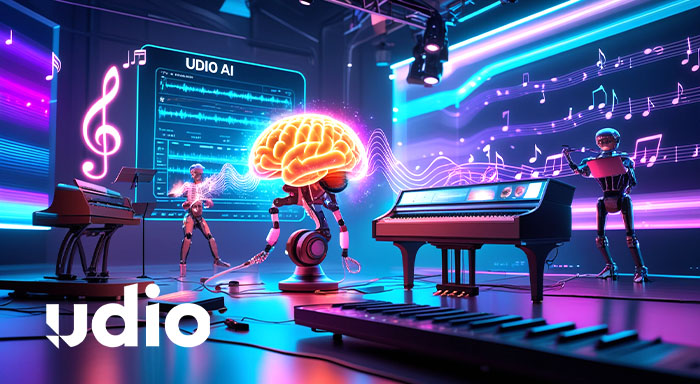
The trajectory of AI music generation technology suggests significant developments ahead, with Udio positioned to play a major role in shaping the future of digital music creation. Understanding these potential developments helps users and industry observers anticipate how the platform might evolve.
Technological improvements in AI music generation focus on several key areas. Audio quality continues to improve as training datasets expand and generation algorithms become more sophisticated. Future versions of Udio will likely produce even more realistic and nuanced musical performances, potentially reaching levels that are indistinguishable from human-created music.
The integration of AI music generation with traditional music production workflows represents another important development area. Future versions of Udio might offer direct integration with popular digital audio workstations, allowing musicians to seamlessly incorporate AI-generated elements into their existing creative processes.
Collaborative features are likely to expand, enabling teams of creators to work together on AI-generated music projects. This could include real-time collaboration, version control systems, and project management features that make AI music generation viable for complex commercial productions.
The platform’s understanding of musical context and emotional nuance will continue to improve, allowing for more sophisticated prompt interpretation and more emotionally resonant output. This advancement could make AI music generation viable for applications requiring subtle emotional communication, such as film scoring and therapeutic music.
Legal and ethical considerations will also shape the future development of AI music generation platforms. As these tools become more sophisticated, questions about attribution, copyright, and the rights of human musicians will influence how platforms like Udio operate and market their services.
The democratization of music creation through AI tools like Udio has broader implications for the music industry. As these platforms become more accessible and powerful, they may enable new forms of musical expression and create opportunities for creators who previously lacked access to professional music production resources.
Conclusion
This comprehensive udio AI review 2025 reveals a platform that has established itself as a significant player in the AI music generation landscape. Udio’s combination of high-quality vocal generation, genre versatility, and user-friendly interface makes it an appealing choice for creators across different skill levels and application areas.
The platform’s strengths lie in its ability to generate complete, professional-sounding songs that can serve both creative and commercial purposes. The quality of its vocal synthesis technology and its sophisticated understanding of musical genres set it apart from many competitors in the ai music free and premium markets.
While Udio faces strong competition from platforms like Suno AI and other best AI music generators, its unique approach to music generation and consistent quality output have earned it a loyal user base. The platform’s pricing structure provides accessible entry points for casual users while offering substantial value for professional creators.
For users seeking an ai music generator free no sign up solution, Udio’s free tier provides genuine value, though the daily limitations encourage upgrades for serious users. The platform’s web-based approach ensures broad compatibility, including udio ai review 2025 android access through mobile browsers.
The future of AI music generation looks promising, with platforms like Udio leading the charge toward more sophisticated, accessible, and powerful music creation tools. As these technologies continue to evolve, they promise to democratize music creation and open new possibilities for creative expression.
Whether you’re a content creator needing background music or just reading this Udio AI Review 2025 to explore creative tools, this platform delivers, or a musician exploring new creative possibilities, Udio AI offers a compelling solution that balances accessibility with professional capability. The platform’s continued development and growing user community suggest that it will remain a significant force in the AI music generation space for years to come.
Frequently Asked Questions
Q: Is Udio AI completely free to use? A: Udio offers a free tier with basic features and daily usage quotas, allowing users to generate a limited number of tracks per day. For unlimited access and additional features, paid subscriptions start at $10 per month.
Q: Can I use Udio AI-generated music for commercial projects? A: Yes, music generated with Udio can be used for commercial purposes when you have an active subscription. The platform provides royalty-free music that doesn’t require additional licensing fees for commercial use.
Q: How does Udio AI compare to Suno AI? A: Both platforms offer high-quality AI music generation, but they have different strengths. Udio excels in vocal expressiveness and genre versatility, while Suno tends to produce more polished, commercial-sounding tracks with better prompt adherence.
Q: Can I use Udio AI on my Android device? A: Yes, Udio AI is accessible on Android devices through web browsers. While there isn’t a dedicated Android app, the web interface is optimized for mobile use and provides access to core features.
Q: What genres of music can Udio AI generate? A: Udio AI can generate music across a wide range of genres, including pop, rock, electronic, hip-hop, country, classical, and many others. The platform’s training includes diverse musical styles and can adapt to specific genre requirements.
Q: How long does it take to generate music with Udio AI? A: Most music generation with Udio takes between 2-5 minutes, depending on the complexity of the request and server load. The platform provides progress indicators during the generation process.
Q: Can I customize the music after it’s generated? A: While Udio doesn’t offer extensive post-generation editing tools, you can refine your prompts and generate variations to achieve desired results. The platform focuses on getting the generation right rather than providing editing capabilities.
Q: Is there a limit to how many songs I can generate? A: The free tier includes daily quotas that limit the number of generations. Paid subscriptions provide higher limits, with the Pro tier offering substantial daily generation allowances for regular users.
Q: Can Udio AI create music in the style of specific artists? A: While Udio can generate music inspired by certain styles and genres, it’s designed to create original compositions rather than copying specific artists. The platform focuses on capturing musical styles and production techniques rather than replicating particular artists’ work.
Q: What audio formats does Udio AI support? A: Udio AI generates music in standard audio formats that are compatible with most audio editing software and platforms. The output quality meets professional standards for various applications including streaming, broadcasting, and commercial use.
